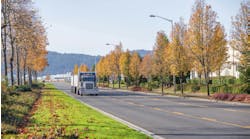Introducing the “Diesel Engines and the Environment Issue Form” at the recent SAE Truck & Bus Meeting, Ludvik F. Koci, vice chairman of Detroit Diesel Corp., said, “Diesel engines have come much farther than we would have believed they could just 15 years ago.”
But because tighter emissions standards are just over the horizon, SAE convened a panel of engine, fuel and environmental specialists to discuss how — or whether — diesels can meet the new challenge. Here are highlights:
“It goes without saying that diesel exhaust emissions are unhealthy,” said Thomas Cackette, chief deputy executive officer, California Air Resources Board. “They're the biggest air toxic concern in terms of exposure for possible cancers, and are about 70% of the air toxics we've identified (in the atmosphere).” But the good news, thanks to new engine standards and local emissions programs, is that while miles traveled is increasing, emissions have been going down.
Under EPA's latest proposed emissions standards, a diesel engine built in 2007 will show a 98% reduction from pre-1998 levels in NOx and particulates, Cackette noted, adding that this will come close to meeting CARB's target of near-zero emissions.
Joe Mauderly, vp/senior scientist, Lovelace Respiratory Research Institute, and former chairman of EPA's Clean Air Scientific Advisory Committee, said that health researchers can't possibly keep up with the emissions evolution: fuels are changing, engines are changing, and aftertreatments are coming online.
Several programs are under way, Mauderly noted, to develop a research pathway to understanding the contributions of different components of air pollution to the health effects of the composite mixture.
Getting down to hardware, Franz X. Moser, executive-vp, AVL List GmbH, a European-based engine-consulting firm, praised the diesel, saying, “No other machine in the world has as broad a range of applications and power output as the diesel engine.”
With sophisticated aftertreatment the diesel will meet mid-term to long-term emissions regulations in the U.S., said Moser, but “we still have a long way to go in developing those technologies.”
The challenge, Moser said, is to meet these regulations at reasonable add-on cost and with no deterioration in fuel economy or durability.
Of other technologies, the engine consultant said:
-
Clean low-pressure EGR (exhaust gas recirculation) holds great promise for reducing emissions while improving fuel economy, but there are problems with possible engine wear and increased cooling requirements.
-
Alternative fuels and combustion systems for internal-combustion engines may show up, long-term, using combinations of aftertreatments.
-
Hybrid drivetrains and fuel cells will find niche applications, but in buses rather than heavy trucks.
Offering the viewpoint of a fuels specialist, Chuck LeTavec, principal engineer, fuel-development, ARCO Products, looked at the pros and cons of lowering NOx limits to 0.02 g/bhp-hr. for 2007. While it could drive technical progress, it could also push introduction of new technology to market before all the bugs have been worked out.
The NOx benefits offered today by alternative fuels — compressed natural gas and liquefied natural gas — are getting smaller, LeTavac said, as new diesel engines come on the market, and by 2007 will be gone. He added that there are particulate-matter benefits in using CNG and LNG vs. diesel, but not over “clean” diesel.


